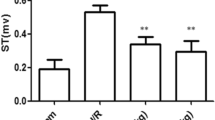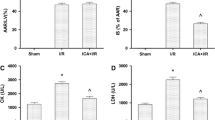ABSTRACT
High mobility group box 1 protein (HMGB1) plays an important role in myocardial ischemia–reperfusion (I/R) injury. B-type natriuretic peptide (BNP) postconditioning has been reported to reduce myocardial I/R injury. The present study investigated whether postconditioning of BNP could reduce myocardial I/R injury by inhibiting HMGB1 expression and the potential mechanisms in rats. The left anterior descending coronary arteries of rats were occluded to induce ischemia for 30 min and reopened to imitate reperfusion for 4 h. The rats were treated with BNP (0.03 μg/kg min, i.v.) 15 min before reperfusion until the end of the procedure, with or without treatment of LY294002 (an inhibitor of phosphoinositide 3-kinase (PI3K), 0.3 mg/kg, i.v.), which was injected 20 min before reperfusion. Lactate dehydrogenase (LDH), creatine kinase (CK), tumor necrosis factor-α (TNF-α), interleukin-6 (IL-6), and infarct size were measured. Phospho-Akt, total Akt, and HMGB1 expression were assessed by immunoblotting. The results showed that treatment of BNP postconditioning could significantly decrease the infarct size and the levels of LDH and CK after 4-h reperfusion (all p < 0.05). BNP postconditioning could also significantly inhibit the increases of TNF-α and IL-6 (both p < 0.05). In addition, BNP postconditioning could significantly inhibit HMGB1 expression induced by I/R (p < 0.05). Administration of LY294002 abolished the effects of BNP postconditioning on myocardial I/R injury and the expressions of phospho-Akt and HMGB1 (all p < 0.05). The present study suggests that postconditioning of BNP could protect against myocardial I/R injury which may be associated with inhibiting HMGB1 expression, while PI3K/Akt signaling pathway may be involved in the expression of HMGB1 and the protective effect of BNP postconditioning.




Similar content being viewed by others
REFERENCES
Scaffidi, P., T. Misteli, and M.E. Bianchi. 2002. Release of chromatin protein HMGB1 by necrotic cells triggers inflammation. Nature 418: 191–195.
Bell, C.W., W. Jiang, C.F. Reich, et al. 2006. The extracellular release of HMGB1 during apoptotic cell death. Am J Physiol Cell Physiol 291: C1318–C1325.
Andrassy, M., H.C. Volz, J.C. Igwe, et al. 2008. High-mobility group box-1 in ischemia-reperfusion injury of the heart. Circulation 117: 3216–3226.
Hu, X., H. Jiang, Q. Bai, et al. 2009. Increased serum HMGB1 is related to the severity of coronary artery stenosis. Clin Chim Acta 406: 139–142.
Andrassy, M., H.C. Volz, N. Riedle, et al. 2011. HMGB1 as a predictor of infarct transmurality and functional recovery in patients with myocardial infarction. J Intern Med 270: 245–253.
Hu, X., W. Zhou, Q. Bai, et al. 2011. Increased serum high mobility group box 1 protein in patients with atrial fibrillation. Biomed Aging Pathol 1: 52–55.
Frangoginis, N.G., C.W. Smith, and M.L. Entman. 2002. The inflammatory response in myocardial infarction. Cardiovasc Res 53: 31–47.
Hu, X., W. Fu, and H. Jiang. 2012. HMGB1: A potential therapeutic target for myocardial ischemia and reperfusion injury. Int J Cardiol 155: 489–489.
Burley, D.S., and G.F. Baxter. 2007. B-type natriuretic peptide at early reperfusion limits infarct size in the rat isolated heart. Basic Res Cardiol 102: 529–541.
Wu, B., H. Jiang, R. Lin, et al. 2009. Pretreatment with B-type natriuretic peptide protects the heart from ischemia-reperfusion injury by inhibiting myocardial apoptosis. Tohoku J Exp Med 219: 107–114.
Ren, B., H. Wu, R. Yin, et al. 2010. B-type natriuretic peptide pretreatment attenuates heart ischemia-reperfusion injury in rats. Transplant Proc 42: 4496–4498.
Sun Y, Deng T, Lu N, et al. B-type natriuretic peptide protect cardiomyocytes at reperfusion via mitochondrial calcium uniporter. 2010;64:170–176.
Hu, X., X. Zhou, B. He, et al. 2010. Minocycline protects against myocardial ischemia and reperfusion injury by inhibiting high mobility group box 1 protein in rats. Eur J Pharmacol 638: 84–89.
Hausenloy, D.J., and D.M. Yellon. 2006. Survival kinases in ischemic preconditioning and postconditioning. Cardiovasc Res 70: 240–253.
Gottlieb, R.A., and R.L. Engler. 1999. Apoptosis in myocardial ischemia-reperfusion. Ann N Y Acad Sci 68: 412–426.
Xiong, J., Y.J. Yuan, F.S. Xue, et al. 2012. Postconditioning with α7nAChR agonist attenuates systemic inflammatory response to myocardial ischemia-reperfusion injury in rats. Inflammation 35: 1357–1364.
Tang, D., Y. Shi, R. Kang, et al. 2007. Hydrogen peroxide stimulates macrophages and monocytes to actively release HMGB1. J Leukoc Biol 81: 741–747.
Tsung, A., J.R. Klune, X. Zhang, et al. 2007. HMGB1 release induced by liver ischemia involves toll-like receptor 4 dependent reactive oxygen species production and calcium-mediated signaling. J Exp Med 204: 2913–2923.
Zhang, Z.W., Q.Y. Zhang, M.T. Zhou, et al. 2010. Antioxidant inhibits HMGB1 expression and reduces pancreas injury in rats with severe acute pancreatitis. Dig Dis Sci 55: 2529–2536.
Yasuda, T., T. Ueda, Y. Takeyama, et al. 2006. Significant increase of serum high-mobility group box chromosomal protein 1 levels in patients with severe acute pancreatitis. Pancreas 33: 359–363.
Sawa, H., T. Ueda, Y. Takeyama, et al. 2006. Blockade of high mobility group box-1 protein attenuates experimental severe acute pancreatitis. World J Gastroenterol 12: 7666–7670.
Cantley, L.C. 2002. The phosphoinostide 3-kinase pathway. Science 296: 1655–1657.
Ha, Y.M., M.Y. Kim, M.K. Park, et al. 2012. Higenamine reduces HMGB1 during hypoxia-induced brain injury by induction of heme oxygenase-1 through PI3K/Akt/Nrf-2 signal pathways. Apoptosis 17: 463–474.
ACKNOWLEDGMENTS
This study was supported by grants from the National Natural Science Foundation of China (Nos. 81100146 and 81370308), the Fundamental Research Funds for the Central Universities (No. 1210486083), the Specialized Research Fund for the Doctoral Program of Higher Education of China (No. 20110141120060), and the Fundamental Research Funds of Wuhan City (No. 2013070104010044).
CONFLICT OF INTEREST
None.
Author information
Authors and Affiliations
Corresponding author
Rights and permissions
About this article
Cite this article
Hu, G., Huang, X., Zhang, K. et al. Anti-inflammatory Effect of B-Type Natriuretic Peptide Postconditioning During Myocardial Ischemia–Reperfusion: Involvement of PI3K/Akt Signaling Pathway. Inflammation 37, 1669–1674 (2014). https://doi.org/10.1007/s10753-014-9895-0
Published:
Issue Date:
DOI: https://doi.org/10.1007/s10753-014-9895-0




